Best Camp Stoves for Lightweight Camping
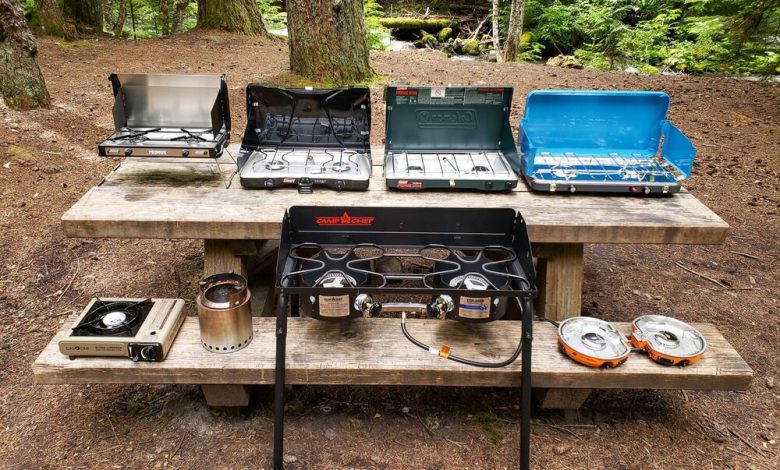
If a propane or gas camp stove is too much to bring along with you camping, look into alcohol stoves. Alcohol stoves are extremely light-weight, portable, quiet and efficient. It’s for this reason that alcohol stoves are the preferred choice for solo or stealth campers. Gas camp stoves are the better option for cooking larger or more elaborate meals with and for performance. Larger touring kayaks can easily store camp stoves but smaller boats may not be able to. The same goes with car camping vs. backpacking. So, here are the Best Camp Stoves for Lightweight Camping.
While it’s true that you’ll trade some performance for portability when using alcohol stoves, a lot also depends on the type of fuel you burn. Certain denatured alcohols burn very well and are clean to boot. Propane gas stoves on the other hand are fast burners and easier to cook larger meals with.
Neither alcohol stoves or isopropane stoves are safe to burn indoors without adequate ventilation. Make sure you cook in a well ventilated area or outdoors with either stove.
In this post we’ll cover when to use alcohol stoves vs. gas camp stoves and the best products in each category.
Alcohol stove pros and cons
Alcohol stoves have had a resurgence lately.
Certain brands like Trangia and Esbit, both of whom are well regarded, have a lot to do with that popularity through innovation and new product offerings. You can now buy a fairly complete stove set with various pots and pans, windscreens, alcohol dispenser bottles, simmer plates, etc.
Best Camp Stoves for Lightweight Camping
Trangia Spirit Burner with Screwcap Versatile
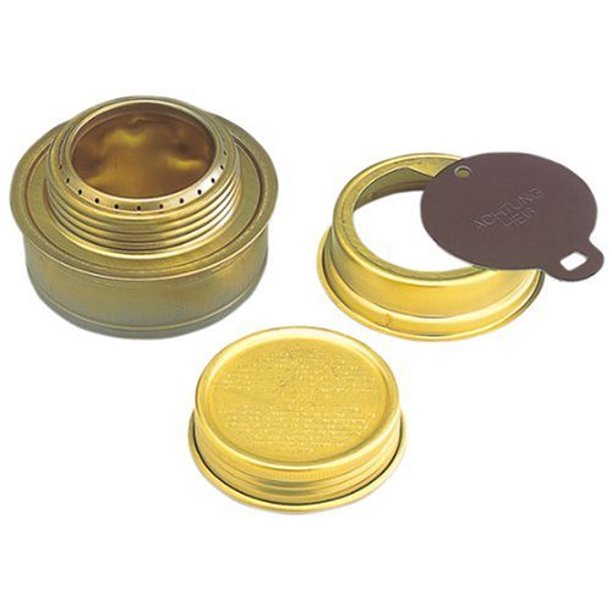
This is the bare bones Trangia burner.
Nothing else is included but the stove.
You’ll want to pair this with a pot stand to hold your pots and pans.
- Uses Alcohol fuel (denatured alcohol preferred)
- Solid Brass construction for burner cup
- Compact size measuring 4.1 x 3.1 x 2 inches
- Weight of 0.18 pounds
- Includes simmer plate and lid for transport
- Boil time: 1 Liter in 8 minutes
Pros:
Alcohol stoves are simple
Simplicity should not be taken for granted. Many campers are looking for the simplest means to cook their foods without making a big production. Alcohol stoves can be fashioned out of old tin can with some holes punctured through for vapors to escape.
The alcohol stoves on the market today take things up several notches with an air-sealed cavity for fuel transport, built-in vapor holes, a simmer ring and lid. The Trangia models are made out of solid brass, are non-stick and look sleek.
To use you pour your denatured alcohol spirt of choice into the brass cup and ignite. After a few seconds the fire ring burners surrounding the cup ignite and you can start cooking. This makes for a nice clean fire with a fairly even burner surface to cook on. Now all you need is surface top to cook on. Simple accessories like pot stands give you that option.
Alcohol stoves are ultra-light to lightweight
Alcohol stoves are mainly designed for backpacking and stealth camping or for general preparedness. This means they need to be light enough to transport on foot for long distances. Perfect also for a bug-out bag. The burner itself is made out of brass and is extremely compact. Accessory items like pots and pans are made out of titanium, light-weight aluminum and aluminum with a stainless steel cooktop.
Esbit Ultralight Folding Stainless Steel Pot Stand with Tray for Alcohol or Solid Fuel Stoves
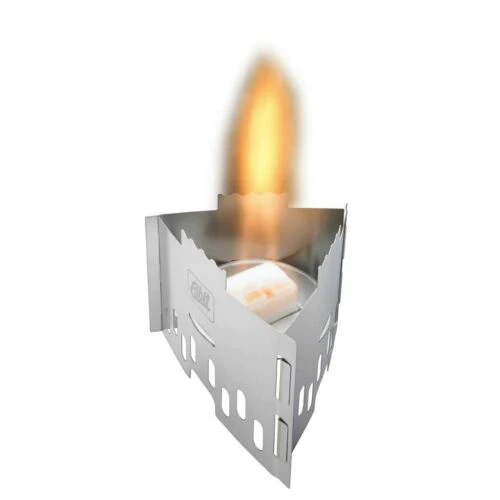
This style of stand is great for lightweight backpacking.
The design is more sturdy than many of the other ultra-light options if you clip together the walls correctly.
Requires quick assembly each time.
The only con here is it can be difficult to put out the fire with this stand.
- Made out of Stainless Steel
- Weighs 3.3 oz
- Measures flat 4.92 x 4.33 x 3.94 inches
- Extremely compact when disassembled and stored
- Fits other brand alcohol stoves as well
Alcohol stove fuel can be cheap and varied
Many people choose alcohol stoves because fuel can be cheap. This is true of fast burning denatured alcohol spirts like marine stove fuel, which is methylated ethanol. This alcohol is undrinkable and has toxic vapors when burned, so avoid breathing them in as best you can. You can easily pick up some clean burning denatured alcohol marine stove fuel at any hardware store. It’s cheap and typically comes in a quarts or liter-sized container.
If you must use Isopropyl alcohol (rubbing alcohol) choose the highest proof alcohol that you can find –typically 90%+ proof.
You can also burn ethanol or grain alcohol — which burns the absolute cleanest — but that is much costlier. But if you’re in a pinch or in a SHTF scenario you can burn your left over liquor supply, no problem.
Ability to accessorize
Reputable companies like Trangia and Esbit offer multiple accessories to go along with your alcohol stove — from pots and pans to windscreens to pot stands. Best of all, these accessories are typically very easy to pack up.
You can have your set up be as simple as a burner and a stand to more complete, multi-stove sets. The pot stands themselves can be as simple as a three-plated stand and windscreen, to more robust configurations. You have the ability to accessorize as you wish and customize to your camping style.
You may even be able to stack your cookware to reduce it’s packable size. Be careful storing your cookware away from your stove and fuel to prevent contamination though.
Low maintenance
Alcohol stoves have few, if any, moving parts. This makes them extraordinarily easy to maintain and clean. They should be cleaned and rinsed off with fresh water every now and then. But other than that they are good to sit unused for long periods of time. The one thing to look out for though is cracks and rot in the rubber O-ring underneath the lid. If there are any signs of damage to the rubber O-ring you should replace it.
Esbit 985ml Stainless Steel Cookset with Alcohol Burner
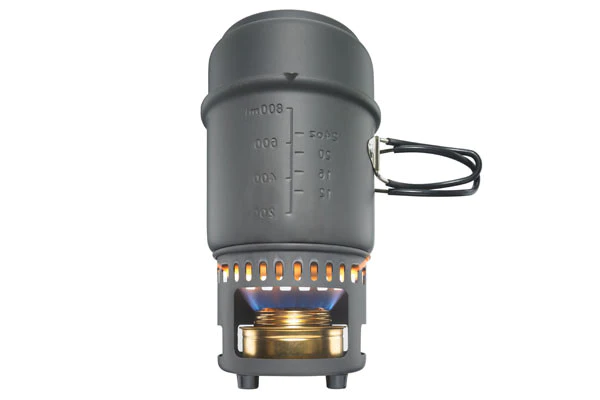
Esbit is another reputable company that makes Alcohol stoves.
This stove cook set is complete with a stand, burner, a 985 ml pot and 470 ml pot/lid
- Made out of Stainless Steel, Aluminum and Brass
- Entire kit stacked measures 4.38 x 4.38 x 9.25 inches
- Pot and burner nest inside pot stand for compact storage
- Includes simmer plate to to reduce heat or extinguish the fire
Cautionary word on alcohol stoves
Alcohol stoves have a translucent flame
One of the most interesting features about alcohol stoves is its translucent flame. Once it’s lit you won’t really be able to easily see whether it’s lit or not. However, you’ll still be able to hear the hissing of the flame or feel its heat if you’re around it. This can make alcohol stoves dangerous if you forget to put it out and hit it over accidentally. Alcohol burns clear to invisible unlike wood. If its dark out you’ll see a little blue flame but you won’t really be able to see the extent of the plume.
Note: This could be a pro in certain situations when you’re trying to not get discovered. But it can be a con if you’re not familiar with how alcohol burns or you’re careless around the fire.
Cons:
Cross contamination from alcohol stoves
Did you know that methanol and denatured alcohols are toxic? You’re probably aware that they’re undrinkable but you may not realize that their residue and soot is also toxic.
The lower proof alcohol typically has the most soot so try to burn the cleaner stuff like marine stove-grade denatured alcohol. Your fire will burn much better as well.
You’ll want to make sure to keep your stove and fuel separate from your cookware at all times. It’s best to store these separately to minimize the risk of cross contamination.
Trangia stoves have air-tight rubber O-ring washers underneath their lid to keep the alcohol from spilling when closed up. That said, I wouldn’t rely on the washers alone, especially if they’re old or worn out. So you’ll still want to pack your stove and fuel separately or even dump out your remaining fuel from the burner if you’re concerned about leakage.
If there is cross contamination, simply wash out your cookware, or anything else contaminated, with water. The downside is you won’t really be able to know there is contamination unless you deliberately look or smell for it.
Alcohol stove vapors are toxic
This one is easy to get around. Simply cook outdoors and try to avoid breathing in the vapors from the burning alcohol.
Methanol fumes contain significant amounts of Carbon Monoxide, much more than gas canister fumes. If you’re indoors, make sure the area you are cooking in — such as in your tent — is well ventilated for these gases to escape.
Slower cook times
Alcohol stoves have reasonable cook times — measured by burn times and average boil time — but they can’t compete with gas stoves here. Gas stoves offer the very best in performance available.
Gas camp stove pros and cons
Pros:
Quicker burn and average boil time
Compared to alcohol stoves, gas stoves are more powerful and should have a quicker burn and average boil time. You may find that these features vary among the different makes and models, but it is the one clear advantage all gas and liquid-fuel stoves have to alcohol stoves.
Performance is the number one reason why you may want to go with a gas canister or liquid fuel stove.
Gas stoves have more consistent heat output
High grade gas canister stoves have a pressure-regulator that provides for a more consistent heat output compared to alcohol stoves. Not only does this making your cooking more even, it helps with performance at high or cold temperatures. You can also regulate how much fuel you are using by modulating the supply.
Gas canister and liquid fuel stoves are also very easy to change the heat on and simmer. You simply restrict the amount of gas flow by turning down the dial. This turns down the heat allowing you to lightly boil or sautee your foots. You cannot do this with an alcohol stove other than by turning in the simmer/damper plate.
Choice of fuel to burn depending on trip
Not all gas stoves are alike. They are mainly differentiated between the type of fuel they burn and how that fuel is stored. The two main gas camp stove fuel types is pressurized gas and liquid fuel.
Pressurized gas canisters contain isobutane and propane. These canisters are disposable — recyclable — after use. You simply screw the threaded gas canister top to your gas stove and you are good to go. You turn on the gas and then ignite it with a match or lighter. No priming necessary.
Liquid fuel stoves burn liquid fuel that you pour into a holding tank attached to an igniter. This fuel is typically kerosene or unleaded gasoline. Priming is often needed.
The white gas from liquid fuel stoves burn much cleaner than methanol does.
Gas canisters are better to bring along with you on lower elevation trips while liquid fuel is preferred at high elevations. The pre-pressurized gas canister might de-pressurize due to the cold.
Note: This post will not go into great detail highlighting the differences between gas canister and liquid fuel stoves.
Ability to accessorize
Like alcohol stoves, you can also accessorize your gas stove.
There are many attachment pieces, burner arms, stands and pots to use with. You can size up or down accordingly.
Gas canister stoves are lighter than liquid fuel stoves and there is no risk of spillage, unlike liquid fuel and alcohol fuel stoves.
Best Canister Gas Camp Stove and Parts
MSR PocketRocket Ultralight Backpacking, Camping, and Travel Stove, PR 2: Ultra Compact
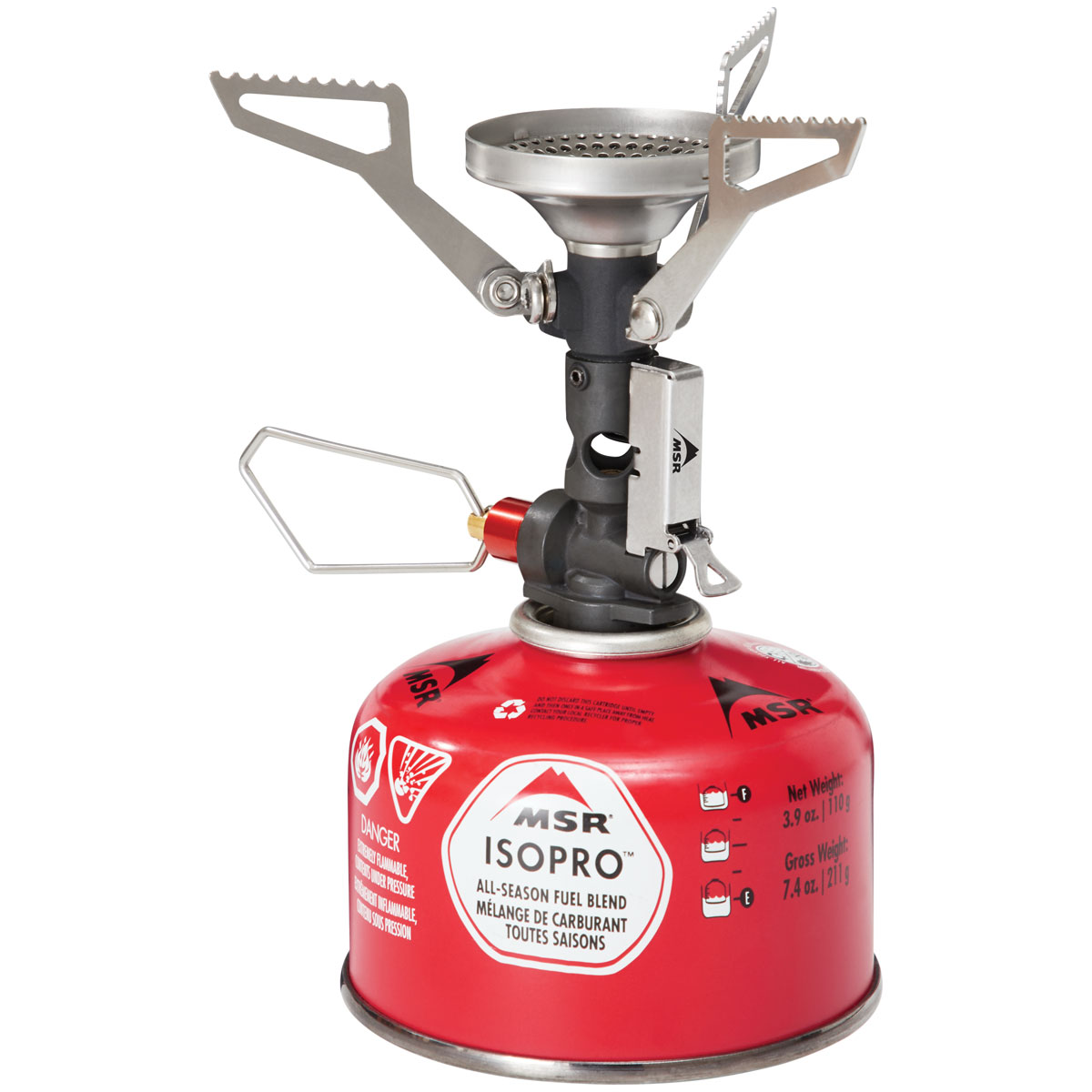
The MSR PocketRocket is the ideal ultralight camp stove. It weighs just 2.6 oz alone, 4.2 oz with case (and +3.2 oz with gas canister) and measures approximately 4.8×4.8×3.6 inches when open and 2x2x3 inches when collapsed. The PocketRocket comes with a case and stand. Fuel is purchased separately.
The MSR PocketRocket boil 1 Liter of water in 3.5 minutes, however it’s lightweight build is it’s main draw.
Jetboil Flash Camping and Backpacking Stove Cooking System
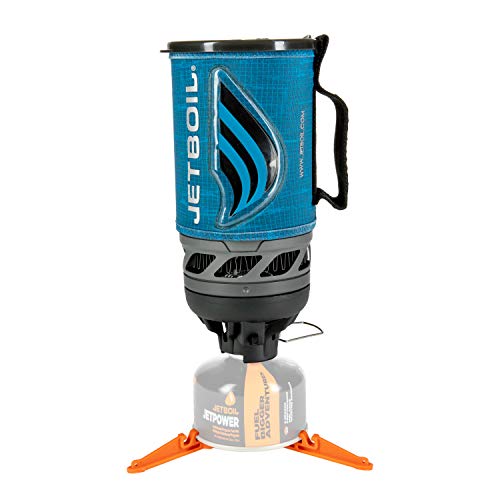
The Jetboil Flash is another good ultralight camp stove. For the Jetboil, performance is key, though it’s still fairly light weight. The Jetboil Flash measures in at 13.1 oz with everything that is included — push button igniter system, fuel canister stabilizer, a bottom cup (doubling as a measuring cup) and a bowl .
Fuel canister and french press attachment sold separately.
The Jetboil Flash records an average boil time of 100 seconds — record time. Get this stove is high performance if necessary.
Best Liquid Fuel Camp Stove and Parts
MSR WhisperLite Universal Canister and Liquid Fuel Stove
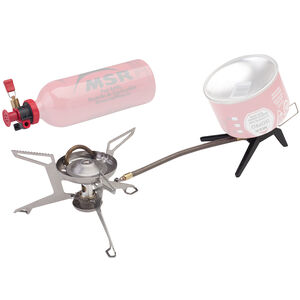
The MSR WhisperLite Liquid Fuel stove is a top of the line product. The stove itself is made out of stainless steel and measures 6 x 8 x 8 inches and weighs 0.72 pounds. So, not as light as an alcohol stove but this is a heavy duty stove for extreme conditions.
The stove includes just the canister stand, fuel pump, windscreen, heat reflector and various small parts and pieces. It does not include the fuel bottle or the liquid fuel itself, both purchased separately.
Cons:
Gas and liquid fuel stoves can be bulky
Whether we’re talking about gas canister or liquid fuel stoves, both are typically heavier and bulkier to transport than a comparable alcohol stove kit. This is why many backpackers and stealth camper go the alcohol stove route.
Gas canister stoves are typically lighter and more compact than liquid fuel stoves, but neither beats the alcohol stove on compactness and portability.
Fuel is more expensive
Propane gas canisters are expensive. Liquid fuel (for white gas) is cheaper but denatured alcohol is still the cheapest option.
Gas and liquid fuel stoves are more expensive
Gas and liquid fuel stoves are quite a bit more expensive than comparable alcohol stoves.
This has mainly to due with the igniter and fuel storage system equipped to them.
As a result they require more preventative maintenance to function at their best. Since they are more expensive, you’re more likely to protect them more than you would with an alcohol stove — though this depends largely on the person.
Gas and liquid fuel stoves require more maintenance and safeguarding
There are more moving parts with gas stoves that require maintenance and eventual replacement. Cheaper model gas stove arms are notorious for breaking off or not opening wide enough or not being stable enough to hold pots and pans. Gas leaks can also go undetected, particularly when you turn on but forget to ignite the gas.
Liquid gas stoves on the other hand require a clean fuel hose to burn efficiently, so this must be cleaned regularly. Additionally, there are a lot of other parts and pieces on both gas and liquid fuel stoves that could get lost or damaged and need to be replaced.


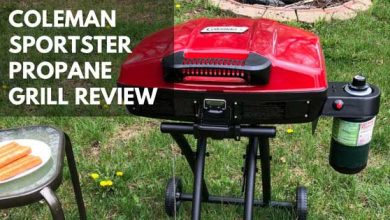
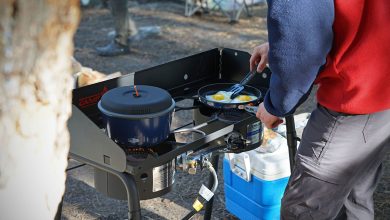

One Comment